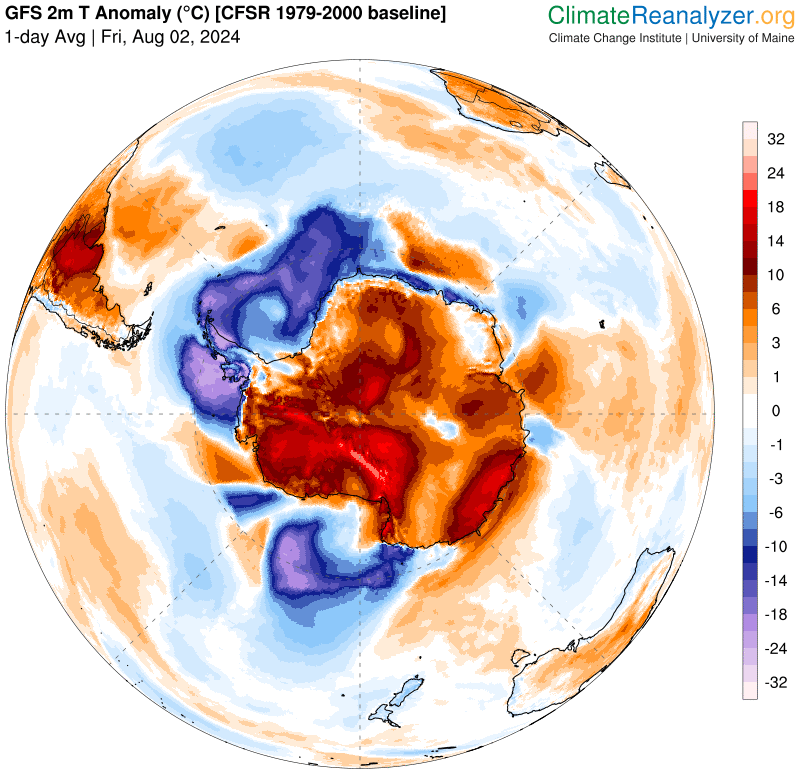The main purpose of this ongoing blog will be to track planetary extreme, or record temperatures related to climate change. Any reports I see of ETs will be listed below the main topic of the day. I’ll refer to extreme or record temperatures as ETs (not extraterrestrials).😉
Main Topic: ‘Extraordinary’ Antarctic Heatwave Puts Temps 50°F/10°C Above Normal
Dear Diary. Everywhere on the planet during this torrid year of 2024 has been hot, and I mean everywhere. There has been no one area of the planet that has not escaped anomalous heat at least some point during this year. Case in point we have Antarctica, which has recently had what is loosely termed as a “heatwave.” Yes, I suppose that if your climatological average max at a coastal location is around -10°F/-23°C, and the temperature gets up to around +40°F/+4.0°C for a few days, that’s a heatwave…even in winter.
Such warmth only leads to more destabilizing of the Thwaites “doomsday” glacier, which if it collapsed, sea levels would quickly rise about eight feet, devastating our civilization.
Today on August 2nd the entire continent of Antarctica appears to remain under this heatwave:

Here are many details on this Antarctic warmth from Common Dreams:
‘Extraordinary’ Antarctic Heatwave Puts Temps 50°F Above Normal | Common Dreams

Seals rest on an ice mass in Antarctica in April 2024. (Photo: Sebnem Coskun/Anadolu via Getty Images)
‘Extraordinary’ Antarctic Heatwave Puts Temps 50°F Above Normal
The long-lasting heatwave is an “eye-opening sign that climate change is starting to really transform the planet,” a climate scientist said.
Aug 01, 2024
Antarctica is experiencing its second extreme heatwave in the last three years, with temperatures more than 50°F higher than normal, The Washington Postreported Wednesday.
The heatwave is notable not just for its intensity but also its timing and duration: It’s hit during Antartica’s winter and is expected to last. Temperatures of 36°F to 50°F above average are expected to persist up to 10 days, and July temperatures were already well above average before it began. The spiking temperatures were also spread across a large area, covering much of the continent, scientists said.
The world has faced exceptionally high temperatures in the last year, with 13 straight monthly heat records and counting, and the poles are warming at roughly twice the rate of the global average. Scientists say the changing conditions around Antarctica have increased the likelihood of higher winter temperatures on the continent.
“It is likely that having less sea ice and a warmer Southern Ocean around the Antarctic continent ‘loads the dice’ for warmer winter weather over Antarctica,” Edward Blanchard, an atmospheric scientist at the University of Washington, told the Post.
Scientists warned that this heatwave was a sign of what’s to come as the planet heats up thanks primarily to fossil fuel emissions.
“This historic warm spell in East Antarctica is an ominous example of the temperature spikes this polar climate could experience more of in a warming world,” the Post reported.
Jonathan Overpeck, a climate scientist at the University of Michigan, said on social media that the heatwave is an “eye-opening sign that climate change is starting to really transform the planet.”
In March 2022, Antarctica experienced the most intense heatwave in the planet’s recorded history, with temperatures up to 72°F above normal. On-site scientists at the time wore shorts and removed their shirts to bask in the sun. The heatwave was the subject of intense scientific research in the two years that followed, with a 54-person team trying to decipher the causes, which they described as “head-hurting” in their complexity.
The 2022 heatwave contributed to reduced sea ice levels. Antarctica experienced the lowest summer and winter levels of sea ice ever recorded last year.
High temperatures in Antarctica are relative—this week’s heatwave still had temperatures hovering at about minus-4°F. But sustained periods at such temperatures are highly unusual.
“The heatwave on the Antarctic Plateau is extraordinary more for its duration than for its intensity, although some values are notable,” Stefano Di Battista, an expert on Antarctic temperatures, told the Post.
The heatwave is likely the result of changes in the stratosphere roughly 20 miles above ground, scientists said. At the South Pole, the stratosphere contains a polar vortex that is normally stable with cold temperatures and low pressure during the Antarctic winter, but a sudden stratospheric warming event occurred due to atmospheric wave activity, Amy Butler, an atmospheric scientist at the National Oceanic and Atmospheric Administration, told the Post.
Our work is licensed under Creative Commons (CC BY-NC-ND 3.0). Feel free to republish and share widely.
Edward Carver is a staff writer for Common Dreams.
More:
Here are more “ETs” recorded from around the planet the last couple of days, their consequences, and some extreme temperature outlooks, as well as any extreme precipitation reports:
Here is more new July 2024 climatology:
Here is More Climate News from Friday:
(As usual, this will be a fluid post in which more information gets added during the day as it crosses my radar, crediting all who have put it on-line. Items will be archived on this site for posterity. In most instances click on the pictures of each tweet to see each article. The most noteworthy items will be listed first.)